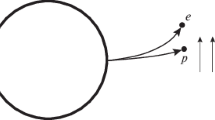Summary
A theory is put forward which explains the generation of a poloidal magnetic field in a star. This theory is not founded on any hypothesis « ad hoc », but only on the braking effect of radiation on the rotation and on other very plausible conditions. When it is applied to the sun it gives, in an infinite time, an uniform field of about 10−3 gauss. By means of a cylindrically symmetric model we show that the field may rise to 10−4 gauss in a time of the order of 5·109 years and that, for times smaller than this, the field increases ast 1/2. For magnetic stars the theory gives a field 103÷104 times greater than that found for the sun. Because these fields are one thousandth of the observed ones they are considered as « seed » fields which must be in so me way amplified. A simple dynamo mechanism in which amplification is obtained through radial oscillations of the layers which confine with the photosphere is outlined. Limiting the amplified field to the low-conductivity photospheric regions, low growth time and inversion of polarities should be possible. The proposed theory seems to be incompatible with the oblique-rotator theory and rules out the necessity of postulating primeval magnetic fields.
Riassunto
Si avanza una teoria che spiega la generazione di un campo magnetico poloidale in una stella. La teoria non si basa su alcuna ipotesi «ad hoc», ma solo sull’effetto frenante della radiazione sulla rotazione e su altre condizioni veramente plausibili. L’applicazione della teoria al sole dà, in un tempo infinito, un campo uniforme di circa 10−3 gauss in tutto il volume del sole. Mediante un modello a simmetria cilindrica abbiamo mostrato che in un tempo τ=5·109 anni il campo raggiunge un valore di circa 10−4 gauss in quasi tutta la stella e che al livello della fotosfera, per tempi molto minori di τ, il campo cresce proporzionalmente at 1/2. L’applicazione della teoria alle stelle magnetiche dà un campo di circa 104 volte maggiore di quello trovato per il sole. Poiché questi campi sono circa un millesimo di quelli osservati, essi debbono essere considerati dei campi «seme» che debbono poi essere in qualche modo amplificati. Nel testo si mostra un semplice meccanismo a dinamo in cui l’amplificazione è raggiunta attraverso delle oscillazioni radiali degli strati che confinano con la fotosfera. Limitando l’amplificazione alle regioni fotosferiche di bassa conduttività, si dovrebbero ottenere sia dei piccoli tempi di crescita sia l’inversione delle polarità. La teoria proposta appare inconciliabile con la teoria del rotatore obliquo ed elimina la necessità di postulare i campi magnetici primordiali.
Реэюме
Предлагается теория обяснения магнитного полойдального поля а эвеэдах. Теория обоснована не на гипотеэах « аd hос », а только на тормоэном зффекте иэлучений на врашение, и на других правдоподобных Гипотеэах. Применение теории в случае солнца, дает, для бесконечного интервала времени, однородное поле во всем об’еме солнца порядка 10−3 Гаусс. При помоши модели с цилиндрической симмeтриеи, мы покаэали, что в интервале времени т=109 Г. поле достигает эначения 10−4 Гаусс во всем об’еме эвеэды и что на уровне фотосферы, при времени иа много меньще чем г, поле увеличивается пропорционално τ, Применение теории к магнитным эвеэдам, дает поле в 103÷104 раэ больще, чем то, полученное для солнца. Так как, такие поля приблиэительно в тысячу раэ меньще наблюдаемых, мы предполагаем, что они являются полями типа «началного поля», которые должны будут в последствии усилены каким либо обраэом. В работе пакаэано применение усиления при помоши механиэма динамо; усиление получено при помоши радиальных колебаний слоев прилегаюших к фотосфере. Если усилениеограничи вается фотосферными областями, которые, как иэвестно, характериэованы ниэкой степенью злектрической проводимости, тогда должно получиться и более ниэкое время роста магнитного поля и обрашение поля. Предлагаемая теория окаэывается непримиримой с теорией косвенногоpотатора и устраняет необходимость постулировать « первоэданные » магнитные поля.
Similar content being viewed by others
References
L. Mestel: inStellar and Solar Magnetic Fields, ed. byR. Lust, I.A.U. Symposium No. 22 (1965), p. 87 and 420; see also report read at the NATO Advanced Study Institute meeting onPlanetary and Stellar Magnetism (Newcastle, 1965).
T. G. Cowling: inStellar and Solar Magnetic Fields, ed. byR. Lust, I.A.U. Symposium No. 22 (1965), p. 405;Magnetohydrodynamics (New York, 1957).
J. H. Jeans:Mon. Not.,86, 328,444 (1926).
C. W. Allen:Astrophysical Quantities (London, 1955).
J. H. Jeans:Astronomy and Cosmogony, Cambridge (1928).
S. Chapman:Astrophys. Journ.,120, 151 (1954).
D. E. Blackwell:Mon. Not.,115, 629 (1955);116, 50 (1956).
S. Chandrasekhar:Principles of Stellar Dynamics, enlarged edition (New York, 1960).
L. Spitzer jr.:Physics of Fully Ionized Gases (New York, 1956); see also:C. L. Longmire:Elementary Plasma Physics (New York, 1963).
E. N. Parker:Interplanetary Dynamical Processes (New York, 1963).
G. N. Watson:Theory of Bessel Functions, 2nd ed. (Cambridge, 1952).
T. G. Cowling:Mon. Not.,105, 166 (1945).
M. H. Wrubel:Astrophys. Journ.,116, 291 (1952).
D. W. Beggs andH. von Klübel:Mon. Not.,127, 133 (1964).
H. C. van de Hulst:Bull. Astr. Nether.,11, 150 (1950).
E. N. Parker:Interplanetary Dynamical Processes, (New York, 1963) Chapter XV.
H. W. Babcock: inStellar Atmospheres, ed. byJ. L. Greenstein (Chicago, 1960).
A. Schuster:Phil. Trans. Roy. Soc., A180, 467 (1889); A208, 163 (1908).
Author information
Authors and Affiliations
Rights and permissions
About this article
Cite this article
Cattani, D., Sacchi, C. A theory on the creation of stellar magnetic fields. Nuovo Cimento B (1965-1970) 46, 258–272 (1966). https://doi.org/10.1007/BF02711426
Received:
Published:
Issue Date:
DOI: https://doi.org/10.1007/BF02711426




